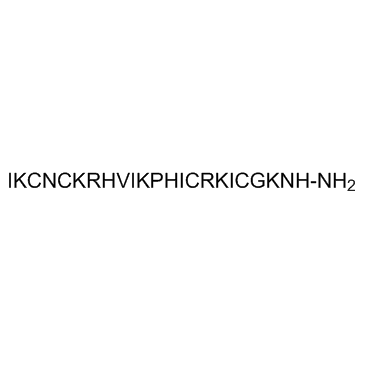Mast Cell Degranulating (MCD) Peptide
Modify Date: 2025-08-20 08:19:52

Mast Cell Degranulating (MCD) Peptide structure
|
Common Name | Mast Cell Degranulating (MCD) Peptide | ||
|---|---|---|---|---|
| CAS Number | 32908-73-9 | Molecular Weight | 2587.22000 | |
| Density | N/A | Boiling Point | N/A | |
| Molecular Formula | C110H192N40O24S4 | Melting Point | N/A | |
| MSDS | N/A | Flash Point | N/A | |
Use of Mast Cell Degranulating (MCD) PeptidePeptide 401, a potent mast cell degranulating factor from bee venom, suppresses the increased vascular permeability due to intradermal injection of various smooth muscle spasmogens (histamine, and 5-HT). |
| Name | MCD peptide |
|---|---|
| Synonym | More Synonyms |
| Description | Peptide 401, a potent mast cell degranulating factor from bee venom, suppresses the increased vascular permeability due to intradermal injection of various smooth muscle spasmogens (histamine, and 5-HT). |
|---|---|
| Related Catalog | |
| Target |
Histamine receptor[1] 5-HT receptor[1] |
| In Vivo | Peptide 401 substantially inhibits the oedema provoked by subplantar injection of carrageenin or intra-articular injection of turpentine in the rat. The ED50 of 401 is c. 0.1 mg/kg. The anti-inflammatory effect is assessed by measurement of the increased 125I-albumin content of an injected site in comparison with an uninjected contralateral site. Peptide 401 also suppresses the increased vascular permeability due to intradermal injection of various smooth muscle spasmogens (histamine, bradykinin, 5-hydroxytryptamine (5-HT), and prostaglandins)[1]. Peptide 401 (MCD peptide) contains 22 residues and occurs in the venom of the common European honey bee to the extent of about 2% by weight . It has powerful anti-inflammatory activity (at doses as low as 0.1 mg/kg) in a variety of animal models, i.e., hind paw oedema in the rat induced by carrageenin or turpentine, adjuvant arthritis in the rat, and increased skin permeability in the rat resulting from subcutaneous injection of bradykinin, prostaglandin E1 kallikrein, histamine and 5- hydroxytryptamine (5-HT). It has a powerful degranulating effect on mast cells and involves the release of histamine and other pharmacologically active agents[2]. |
| References |
| Molecular Formula | C110H192N40O24S4 |
|---|---|
| Molecular Weight | 2587.22000 |
| Exact Mass | 2585.39000 |
| PSA | 1170.06000 |
| LogP | 6.11070 |
CHEMICAL IDENTIFICATION
HEALTH HAZARD DATAACUTE TOXICITY DATA
|
| MCD Peptide |
| Mast Cell Degranulating Peptide |
| Peptide 401 |
| Mast cell degranulating peptide |